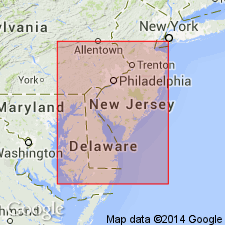
- Usage in publication:
-
- Spring Lake beds*
- Modifications:
-
- First used
- Dominant lithology:
-
- Gravel
- Sand
- AAPG geologic province:
-
- Atlantic Coast basin
Summary:
The "Trenton Gravel" is subdivided into the Spring Lake beds and Van Sciver Lake beds. Spring Lake beds (graywacke 2 of Owens and Minard, 1975) have surface altitudes of 10.4-21 m and are present in the upper reaches of the lowland subprovince between Trenton, NJ, and Philadelphia, PA. Most of these deposits are within the Delaware River Valley. Exposures of this unit within the Assunpink Valley are far and widely scattered. Typically, this formation consists of two lithologies--a lower yellow-brown gravelly sand, and an upper pale-reddish-gray to pale-gray gravelly sand. Salisbury and Knapp (1917) and MacClintock and Johnson (1956) considered the upper bed to be the Cape May Formation and the lower bed, the Pensauken Formation. Authors do not agree with these interpretations. Biostratigraphic dating of the beds yields a Sangamonian age. Fig. 40 shows beds extending to DE along the Delaware Bay.
Source: GNU records (USGS DDS-6; Reston GNULEX).
For more information, please contact Nancy Stamm, Geologic Names Committee Secretary.
Asterisk (*) indicates published by U.S. Geological Survey authors.
"No current usage" (†) implies that a name has been abandoned or has fallen into disuse. Former usage and, if known, replacement name given in parentheses ( ).
Slash (/) indicates name conflicts with nomenclatural guidelines (CSN, 1933; ACSN, 1961, 1970; NACSN, 1983, 2005, 2021). May be explained within brackets ([ ]).

